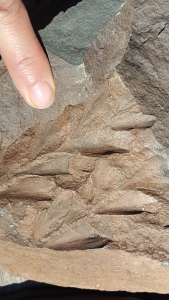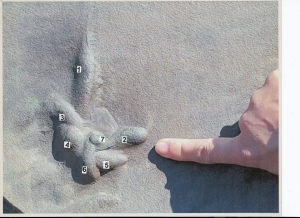Plants and animals and cobbles in a Bearsville quarry
On the Rocks; The Woodstock Times; Aug. 12, 2017
Robert and Johanna Titus
We often look up into the hills above us and wonder what’s up there. We just can’t go everywhere; we can’t explore all the high slopes and mountaintops in all the Catskills. That’s beyond a lifetime of exploration. But, we can’t help it if we wonder what we are missing. Recently we got a chance to find out just a little about what is up there. We heard from Meryl Hyatt, a summer resident of Bearsville. She and her husband Steve have a home on a hill north of Rte. 212. Their property includes a pair of old bluestone quarries and they had found some fossils in those strata. Could we come and take a look. Well, one of us, Robert, did just that.
Upon arrival, a host of Hyatt family and family friends were waiting in greeting. We are sometimes surprised to find out just how many readers we have. They described a steep hike up the hill, but first they had a pile of fossils that needed to be identified. We always enjoy that; it’s our version of “Antiques Road Show.” The prize specimen was a fine fossil Devonian Catskill plant. It was a form that is well known here in the Catskills; it is called Archeopteris (Not to be confused with the Jurassic bird Archaeopteryx.) It had been collected in one of the quarries we were set to explore.

Soon we were off; our climb took a while and it was steep, but we did get there. Our topographic map told us we had ascended 500 feet. The two quarries were at the same level and located near to each other. It was obvious right from the start, that these had once been two very high quality bluestone quarries. The strata were relatively flat-lying and thin-bedded. These rocks must have been easily split into sidewalk slabs and that is what bluestone quarrying was mostly about. We were having fun, but we could not help but to think about all the backbreaking hard work that had been done here a century ago.
Strata of this sort were mostly deposited in the middles of large Devonian age rivers, the very rivers that crossed the old Catskill Delta, perhaps 380 million years ago. If you have been a frequent reader then you know that the Catskill Mountains are an enormous petrified delta complex. They comprise a lithified landscape called the Catskill Delta. These two quarries were representative samples of that delta.
Such thinly laminated strata speak of relatively fast flowing river currents. Our group had been transported to the middle of a very large and very wide river and we were all being swept along by its powerful currents. Then, suddenly we found hard evidence for that interpretation. We found a two inch cobble in the midst of the river sandstones. It had been nicely rounded during its journey down the river. This was nature’s lapidary work. Think about how strong the currents must have been to roll along a cobble of this size. It was an unusual find; things like this are rare in the Catskills.
We continued our mind’s eye journey. We “swam to shore” and found the Devonian river banks lined with Devonian trees. Those were all of the genus Archeopteris. The trunks leaned over the waters and the foliage at the top was composed of dense leaves. It did not, in any way, look like anything is the forest of today’s Catskills. These Devonian trees are called progymnosperms; they were early ancestors of today’s conifers and evergreens.
We poked along the quarry walls. Then we looked up and saw what appeared to be evidence of some of the animals who had long ago, lived in our stream. They had left markings on the sands of the river channel (see our first photo). Those had hardened into rock. We had no idea what kinds of animals they might have been but we could see that they had been poking about on the floor of the river channel. We guessed that, all those 380 million years ago, these animals had been searching for something to eat in the river sands. We surmised they had been some sort of carnivores. But we could not be sure. Those poking marks are called trace fossils, they record brief moments of activity in the lives of ancient organisms. We can never be absolutely sure what those creatures had been up to, but they must have been searching for something.

Then we made the prize find of the day. Take a look at our 2nd photo. It is simply an especially good example of what we had been seeing. We are going to give you our interpretation of what we think happened so long ago. It is guesswork, but informed guesswork. It comes with no guarantees. Our animal, it would seem, had been swimming through the water sniffing for food. It was attracted to something in the river sands. It descended and “came to earth.” Then it startled poking. We have numbered the pokes in the order that we think they were made. This was just the sort of things we were hoping for; it was a tantalizing find.
Pokes one through six were searching marks, or so it seemed. Our predator was getting itself closer and closer to what it was searching for. Then poke seven was the final stab. We are betting that this creature made its catch. I had won its meal.
You can never be sure of yourself when you are making speculations of this sort. We will never know what really happened at this location on that day so long ago. But we were privileged to take a glimpse into the past and that was good enough.
Contact the authors at randjtitus@prodigy.net. Join their facebook page “The Catskill Geologist.





